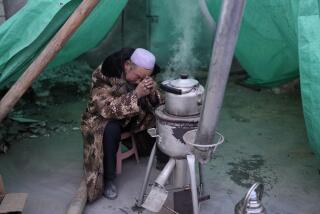Afghanistan-Pakistan quake survivors begin to rebuild; aid is slow in coming
For two days, Agha Mohammad has worked to restore the wall of his storage room, which collapsed in this week’s magnitude 7.5 earthquake in Afghanistan.
Laying mud bricks on Wednesday afternoon in the poor Kabul neighborhood of Shor Bazaar, Mohammad was thankful that his family of eight was spared injury but said he had little choice but to repair the storage room himself before the city’s harsh winter.
“If I don’t do it, who will?” the 33-year-old driver said.
Two days after the quake, most survivors in Afghanistan and Pakistan were waiting for government assistance that was slow to arrive in major cities as well as the far-flung mountain regions that suffered the most extensive damage. The epicenter was located in Afghanistan’s northeastern Badakhshan province, an isolated area bordering China, Pakistan and Tajikistan.
Pakistan’s disaster management agency raised the death toll from the quake to 267, along with more than 1,800 wounded. Afghanistan has said 115 of its people have died. More than 19,000 homes in both countries suffered damage.
Neither country has requested international assistance, with each saying its emergency management agencies are equipped to handle the disaster response.
The relief effort has been complicated in Afghanistan by the fact that parts of Badakhshan and other affected provinces are under Taliban control. The insurgent group issued a statement Tuesday pledging to cooperate in the response, but Afghan officials acknowledge the presence of insurgents has slowed the delivery of emergency supplies.
Wais Ahmad Barmak, the head of the Afghanistan National Disater Management Authority, said teams had been sent -- some on foot or riding donkeys -- to remote areas and would report back on damage. Barmak told the Afghan parliament that some quake-affected areas are difficult to access quickly while others have a heavy Taliban presence.
Jerm, the district at the epicenter, about 160 miles northeast of Kabul, has previously been occupied by the Taliban and been attacked by the militant group several times over the last two years. Wardoj, a neighboring district, was reportedly captured by the Taliban Oct. 2.
The United Nations Office for the Coordination of Humanitarian Affairs said Afghanistan had enough emergency shelter kits for more than 8,000 people, but that seemed likely to be insufficient with more than 7,630 homes reportedly damaged across nine provinces.
In Kabul, the Afghan capital, at least 70 people were reported injured, and most of the structural damage came in poor, older neighborhoods such as Shor Bazaar, where most houses are made of mud and the streets aren’t paved. Some residents were using tarps and scrap materials to patch up their homes.
Ahmad Ahmadi, a local representative who serves as a liaison with the city government, said no officials had come to inspect the area.
“If the government doesn’t even know what’s going on in it’s own capital, how can they ever assist far-flung areas in other provinces?” Ahmadi said.
Agha Mohammad has given up his day job to finish the repairs to his home before the cold sets in. He estimated that the repairs would cost him nearly $100 – nearly two weeks’ wages.
The quake has left an emotional toll on the city’s residents. Five-year-old Fatema, who was home with one of her aunts when the quake struck, said she is afraid the house “will fall over.” Cracks running from the floor to ceiling spread along several of the walls, and the girl’s mother, Magol, said she and her disabled husband might never be able to afford repairs.
“These cracks scare me,” Magol said. “Every time I look at them I feel as if they will split open.”
Special correspondent Latifi reported from Kabul and staff writer Bengali from Mumbai, India.
For more news from South Asia, follow @SBengali on Twitter
More to Read
Start your day right
Sign up for Essential California for news, features and recommendations from the L.A. Times and beyond in your inbox six days a week.
You may occasionally receive promotional content from the Los Angeles Times.







